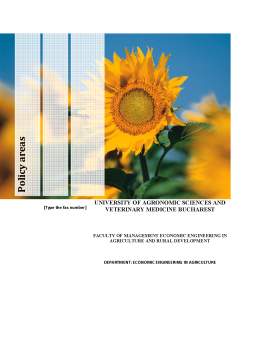Extras din referat
Policy areas
Agriculture
"The Common Agriculture Policy has adapted both to internal needs and challenges and to international developments. However, nothing that we have achieved so far in stability of food supply can be taken as granted! Agriculture is not only a food producer but also a provider of public goods, which are important to the European citizen – environmental protection, optimal use of natural resources, preventive measures for climate change, animal welfare."
– Dacian Cioloş
EU Agriculture & Rural Development Commissioner
The aim of the EU Common Agricultural Policy (CAP) is to provide farmers with a reasonable standard of living, to furnish consumers with quality food at fair prices and to preserve EU rural heritage and environment.
Towards a More Efficient Agricultural Policy
Established in 1962 when the founding members of the EU were emerging from more than a decade of food shortages, the Common Agricultural Policy began by subsidizing production of basic farm products in the interests of self-sufficiency and securing enough food. This policy, however, resulted in almost permanent surpluses of a number of products.
Fundamental reforms of the CAP, begun 1992 with the latest round in 2003, have radically transformed and reduced the levels of support offered to EU farmers at a time when the number of EU farms has steadily increased with EU enlargement. Subsidies on quantities produced have largely been replaced by payments to farmers to guarantee that they receive a decent income and are linked to compliance with broader objectives. These include environmental standards, food safety and the health of animals and plants. Farmers are also expected to keep their land in good condition in order to preserve traditional rural landscapes, birds and other wildlife.
By paying increasing attention to hygiene, food quality and animal welfare, the EU addresses concerns that more intensive farming and animal husbandry were to blame for “mad cow disease,” dioxin in milk, artificial hormones in meat and other food-related health scares.
The 2003 reforms also equipped the CAP for EU enlargement in May 2004, when the 15 Member States became 25 and the number of farmers in the EU increased by nearly 70%.
and Freer World Trade
Moving from support for products to support for farmers leads to fairer world trade, since support for the farmers who need it most reduces the risk that trade will be distorted by EU export subsidies for additional production. This has prepared the EU for the Doha Round of international trade liberalization (World Trade Organization – WTO) talks, where the EU has offered to eliminate export subsidies altogether by 2013. However, even without further liberalization, the EU is already the world's largest importer of food and the biggest market for Third World foodstuffs.
Environment
"Our environment is one of the toughest challenges. Not least because the scope of the problems we have to deal with; things like nature and biodiversity, water, waste, forests, air quality and noise, to name only a few. These are global issues, which affect us all."
– Janez Potočnik
EU Environment Commissioner
"Climate change is one of the biggest challenges of this century As the EU's first Climate Action Commissioner, I see myself as having a two-fold mission. First, to implement the Climate and Energy package Second, I will continue my efforts towards reaching an ambitious international climate agreement. The EU has played a tremendously important role in paving the way for changes in the way we view climate change. I am determined to continue to raise awareness and to deliver solutions. I want to pursue the negotiations with the aim of reaching the 30% emissions reduction target as soon as possible. How Europe chooses to tackle the climate challenge over the next years will largely define our strategic role in the world."
- Connie Hedegaard
EU Climate Action Commissioner
EU-US Approaches to Environment
The European Union is at the forefront of international efforts to deal with global environmental concerns, convinced that major challenges such as Climate Change have to be tackled through the multilateral process. Climate Change is one of the greatest environmental and economic threats facing the planet and the EU's commitment to the Kyoto Protocol was once again reaffirmed on May 31, 2002 when the EU and its Member States ratified the Protocol. The US decided to withdraw from Kyoto in March 2001.
Preview document
Conținut arhivă zip
- Policy Areas.docx



















